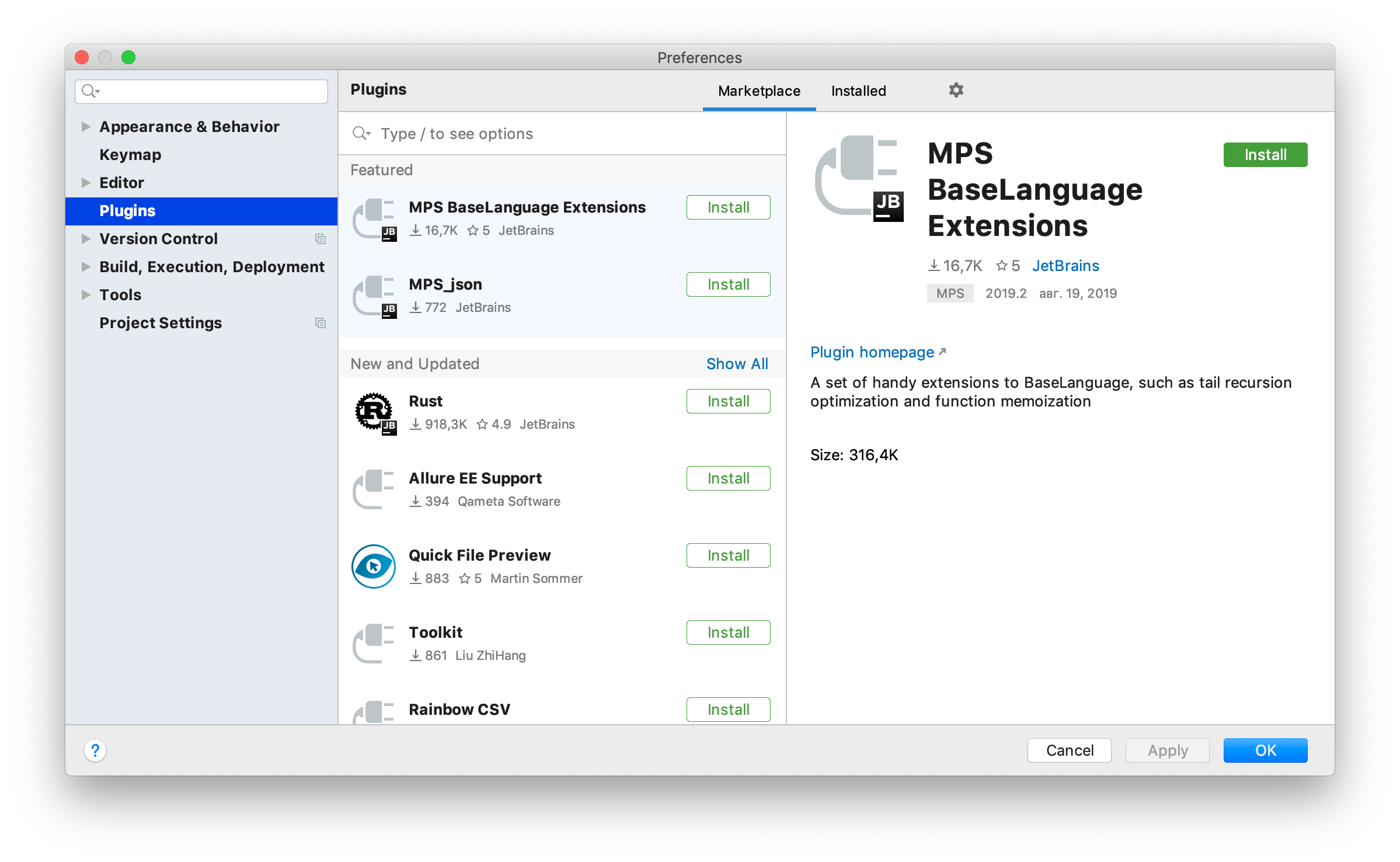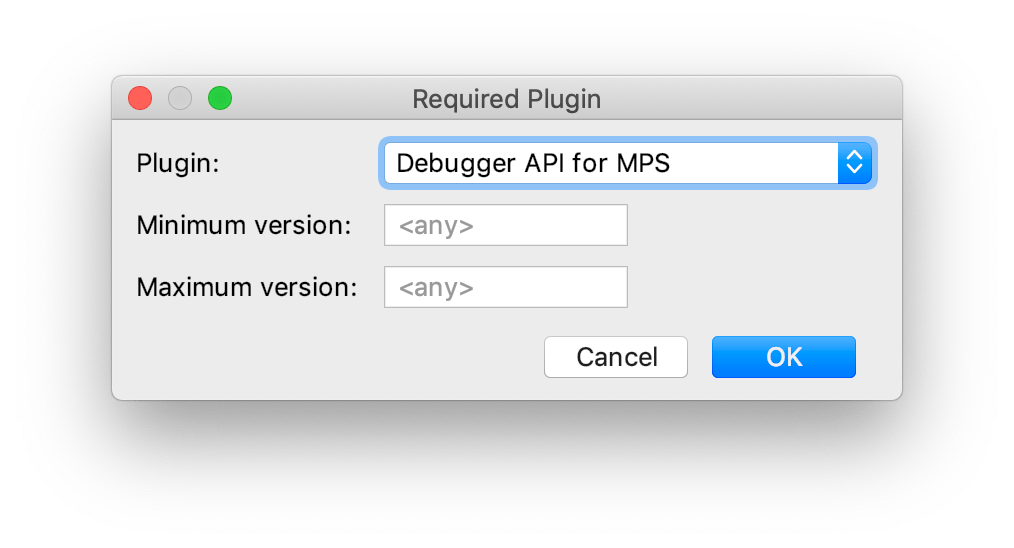Manage plugins
Last modified: 20 September 2022Plugins extend the core functionality of MPS. For example, install plugins to get the following features:
Integration with version control systems, issue trackers, build management servers, and other tools.
Coding assistance support for various languages and frameworks.
Shortcut hints, live previews, File Watchers, and so on.
Coding exercises that can help you to learn a new programming language.
Open plugin settings
Press Ctrl+Alt+S to open the IDE settings and select Plugins.

Use the Marketplace tab to browse and install plugins from the JetBrains Plugin Repository or from a custom plugin repository.
Use the Installed tab to browse bundled and installed plugins, enable, disable, update, or remove them. Disabling unnecessary plugins can increase performance.
Most plugins can be used with any JetBrains product. Some are limited only to commercial products, others require a separate license.
If a plugin depends on some other plugin, MPS will notify you about the dependencies. If your project depends on certain plugins, add them to the list of required plugins.
If existing plugins do not provide some functionality that you need, you can create your own plugin for MPS. For more information, see Develop your own plugins.
By default, MPS includes several bundled plugins. You can disable bundled plugins, but they cannot be removed. You can install additional plugins from the plugin repository or from a local archive file (ZIP or JAR).
Press Ctrl+Alt+S to open the IDE settings and select Plugins.
Find the plugin in the Marketplace and click Install.
To install a specific version, go to the plugin page in the JetBrains Plugin Repository, download and install it as described in Install plugin from disk. For example, you can do it if the most recent version of the plugin is broken.
Download the plugin archive (ZIP or JAR).
Press Ctrl+Alt+S to open the IDE settings and select Plugins.
On the Plugins page, click
and then click Install Plugin from Disk.
Select the plugin archive file and click OK.
Click OK to apply the changes and restart the IDE if prompted.
You can disable a plugin without removing it if you do not need the corresponding functionality.
Press Ctrl+Alt+S to open the IDE settings and select Plugins.
Open the Installed tab, find and select the plugin that you want to disable.
Click
on the plugin's description pane and select Disable.
Alternatively, you can use the checkboxes in the list of plugins or the Disable All buttons for plugin categories.
You can disable or enable all manually installed plugins at once (non-bundled) in the menu under .

Required plugins
A project may require plugins that provide support for certain technologies or frameworks. You can add such plugins to the list of required plugins for the current project, so that MPS will verify that the plugins are installed and enabled. It will notify you if you forget about some plugin, or someone on your team is not aware about the dependency as they work on the project.
Add a required plugin for your current project
Make sure the required plugin is installed.
Press Ctrl+Alt+S to open the IDE settings and select Build, Execution, Deployment | Required Plugins.
On the Required Plugins page, click
and select the plugin. Optionally, specify the minimum and maximum version of the plugin.

tip
To specify the required version of MPS itself, add IDE Core to the list of required plugins.
When you open the project in MPS, it will notify you if the plugin is disabled, not installed, or requires an update.
Click the link in the notification message to quickly enable, install, or update the required plugin.
Develop your own plugins
You can use any edition of MPS to develop language plugins as well as standalone IDEs for your languages. For more information, see the Building MPS Language Plugins Guide
Custom plugin repositories
By default, MPS is configured to use plugins from the JetBrains Plugin Repository. This is a public repository where everyone can host their plugins. However, if you develop plugins for internal use only, you can set up a custom plugin repository for them.
For information about setting up a custom plugin repository, see the IntelliJ Platform SDK documentation.
Once you set up your plugin repository, add it to MPS:
Press Ctrl+Alt+S to open the IDE settings and select Plugins.
On the Plugins page, click
and select Manage Plugin Repositories.
In the Custom Plugin Repositories dialog, click
and specify your repository URL. It must point to the location of the updatePlugins.xml file. The file can be on the same server as your custom plugins, or on a dedicated one.

Click OK in the Custom Plugin Repositories dialog to save the list of plugin repositories.
Click OK in the Settings/Preferences dialog to apply the changes.
When you search for plugins, MPS will show you results both from the default JetBrains Plugin Repository and any custom repositories that you specify. To browse only a certain custom plugin repository, type repository: followed by the URL of the repository in the search field on the Marketplace tab of the Plugins page. For example:
repository:http://plugins.example.com:8080/updatePlugins.xml myPluginAlternatively, you can add your custom plugin repositories using the idea.plugin.hosts property:
From the main menu, select Help | Edit Custom Properties.
Add the
idea.plugin.hostsproperty to the platform properties file and specify the URL of the updatePlugins.xml file. For example:idea.plugin.hosts="http://plugins.example.com:8080/updatePlugins.xml"note
To add multiple URLs, separate them with semicolons
;.Restart MPS.
You may want to replace the default JetBrains Plugin Repository with your custom plugin repository. This can be helpful if you want only your custom repository plugins to be available from MPS.
From the main menu, select Help | Edit Custom Properties.
Add the
idea.plugins.hostproperty to the platform properties file and specify the URL of the application that can properly handle requests from MPS, that is, act as the default plugin repository application instead of JetBrains Plugin Repository.In particular, it should handle the following requests:
Restart MPS.
If you replace the default plugin repository, the search field on the Marketplace tab of the Plugins dialog will browse only the plugins in the new default repository and any custom repositories that you add.
